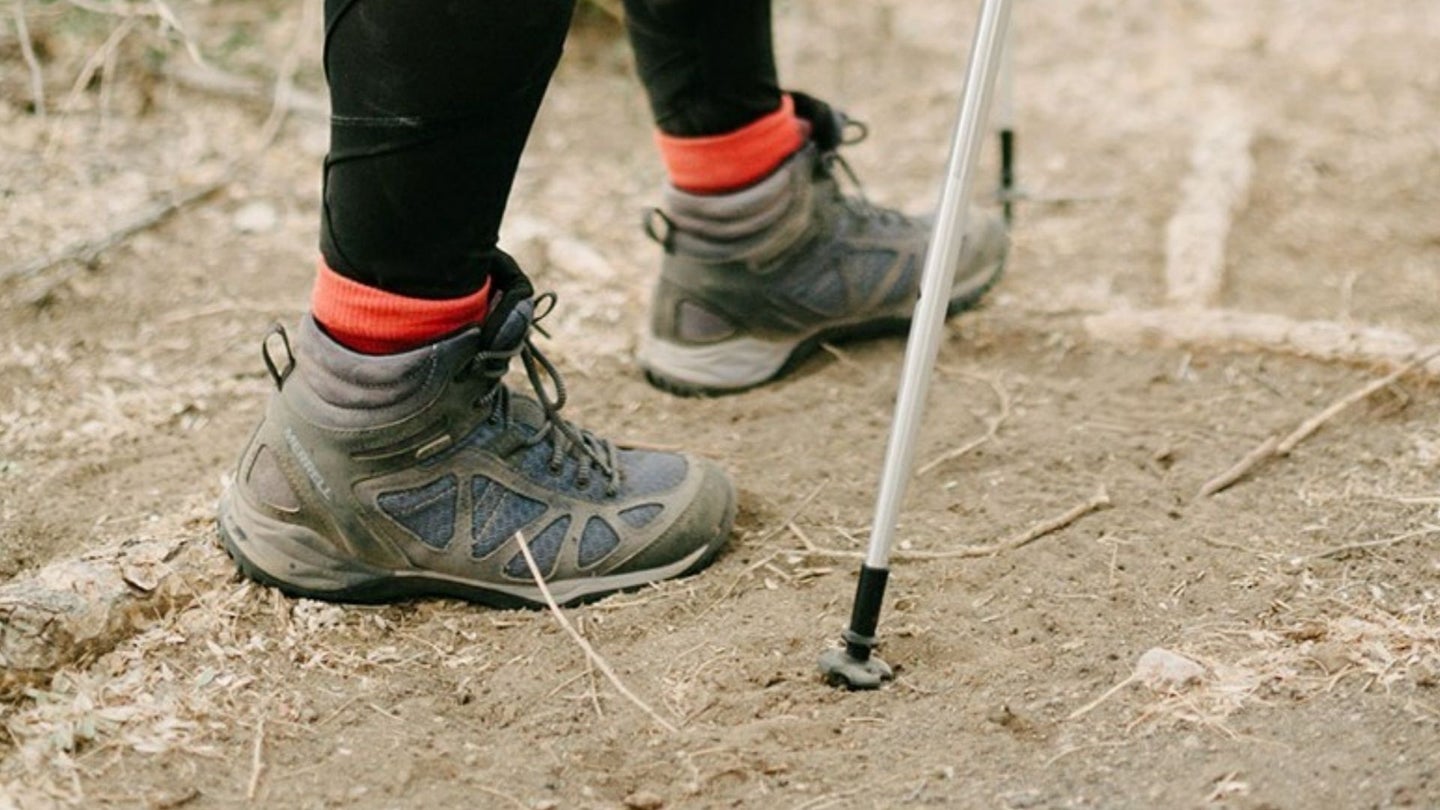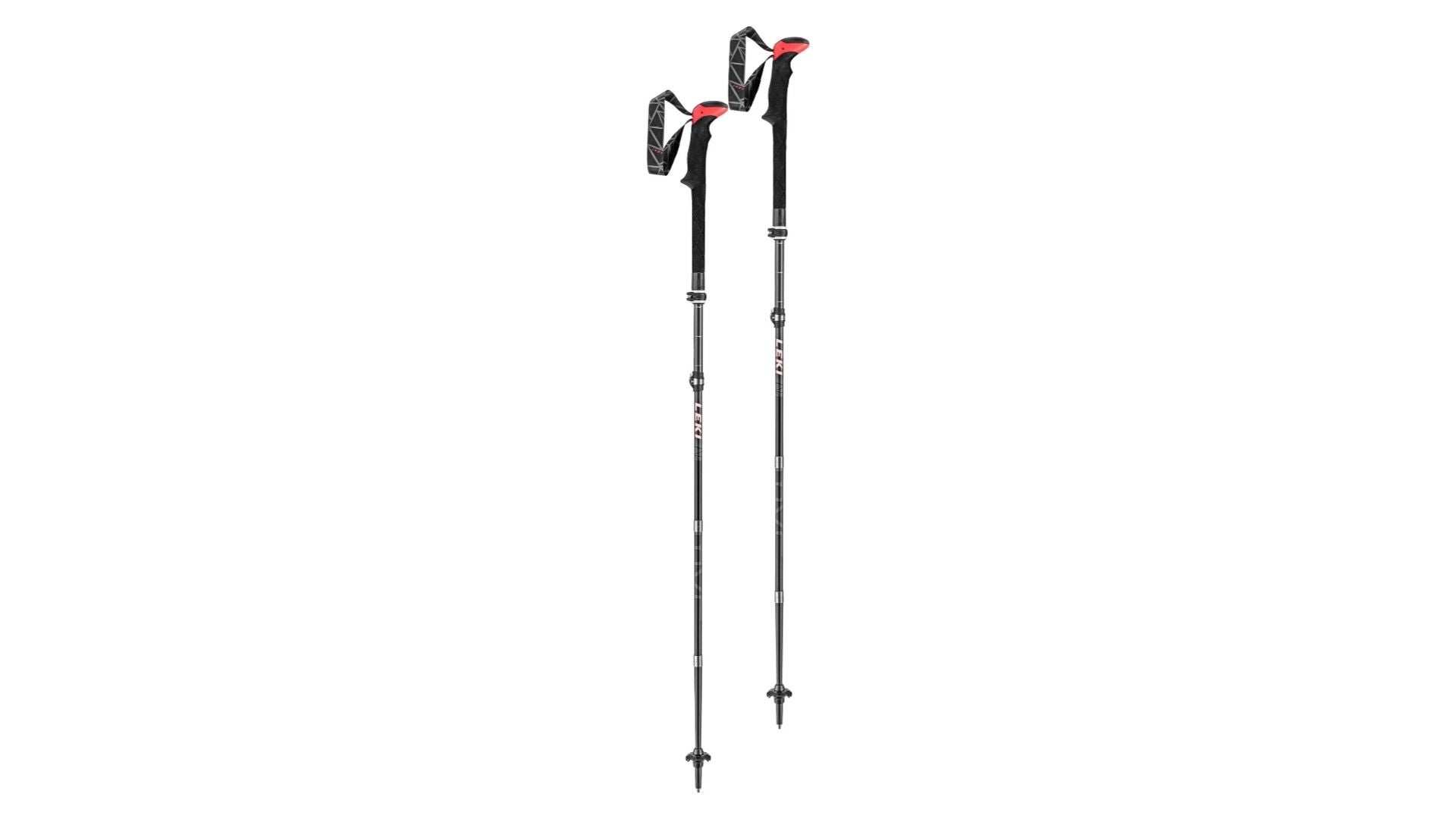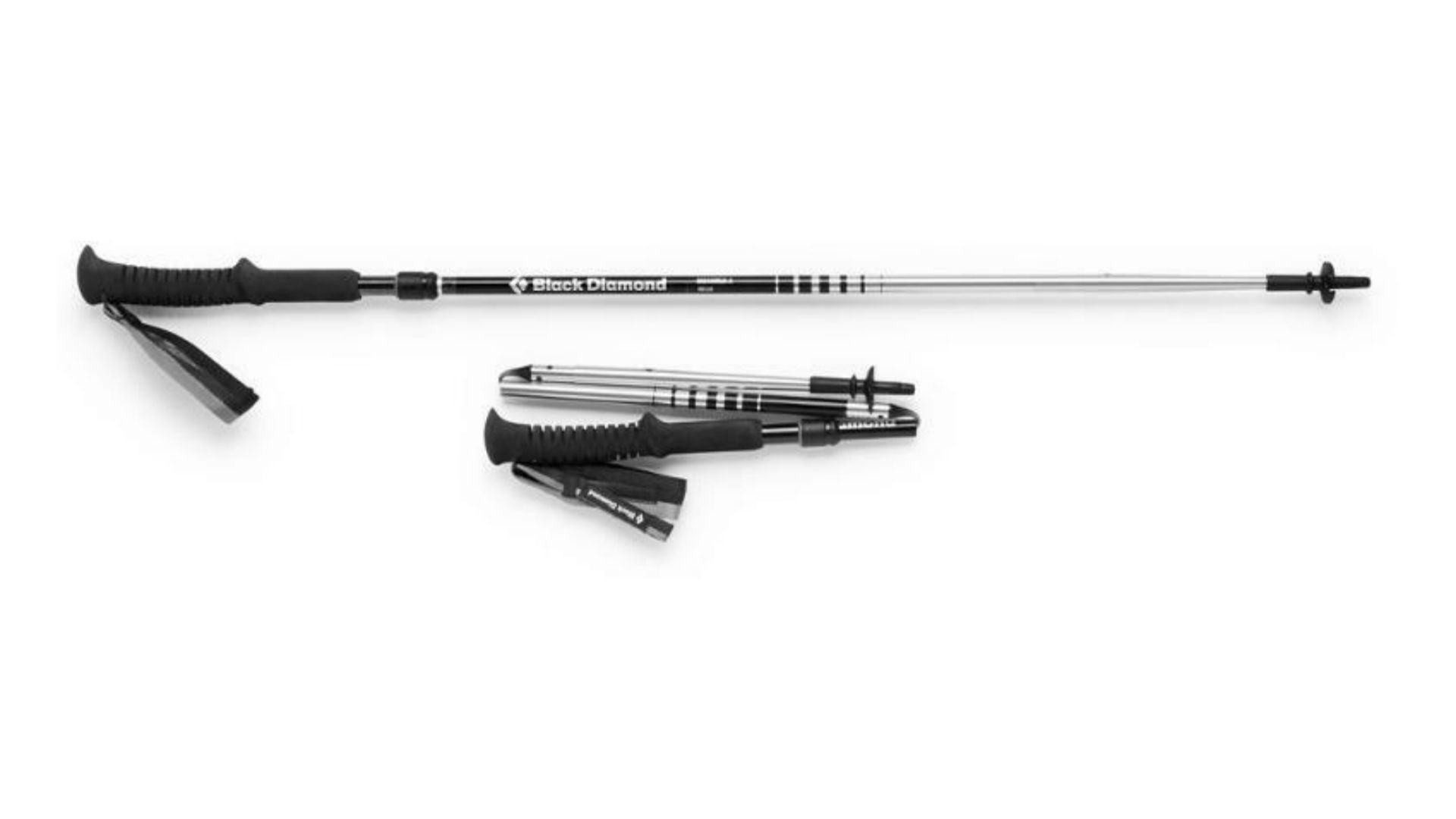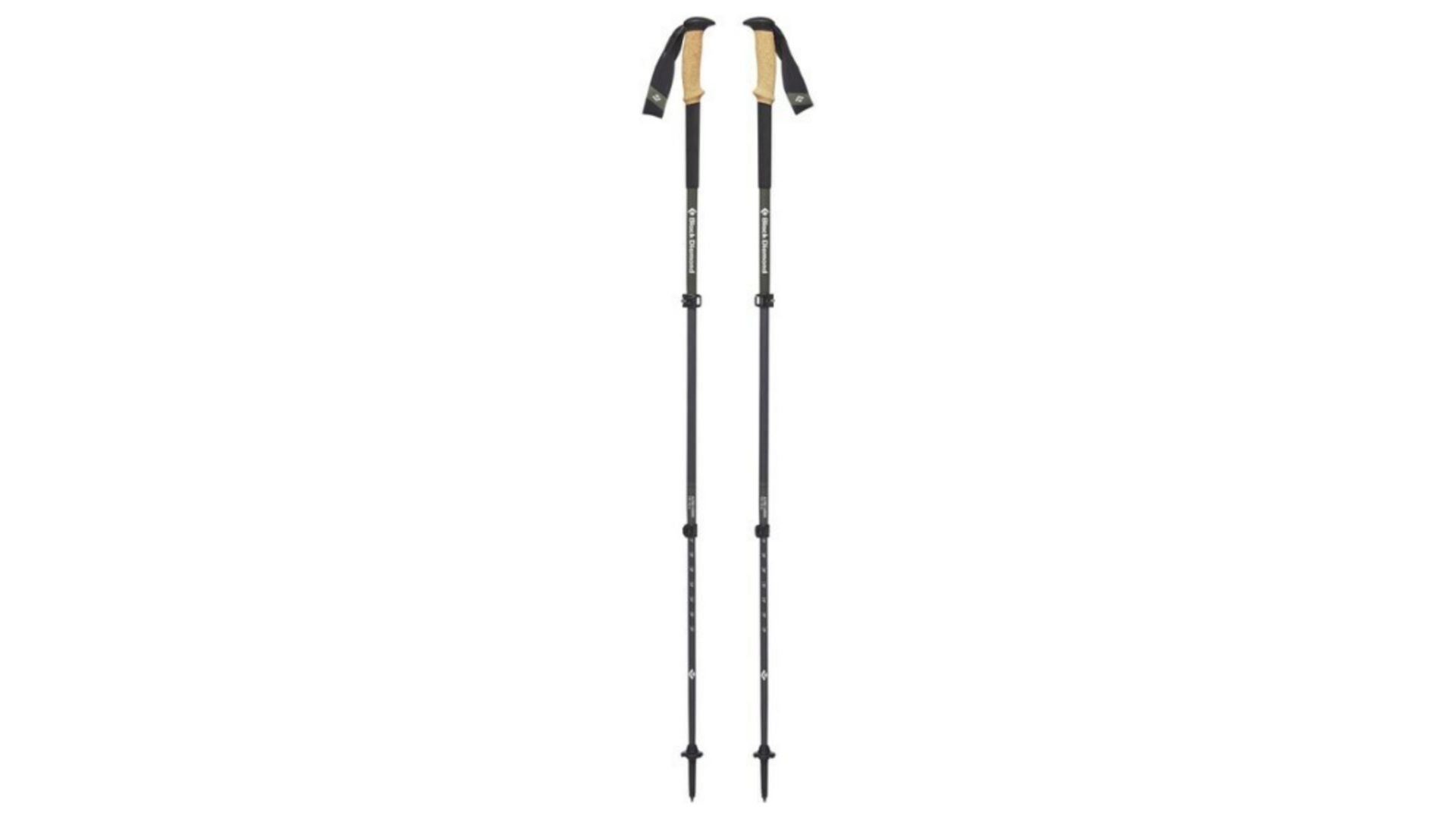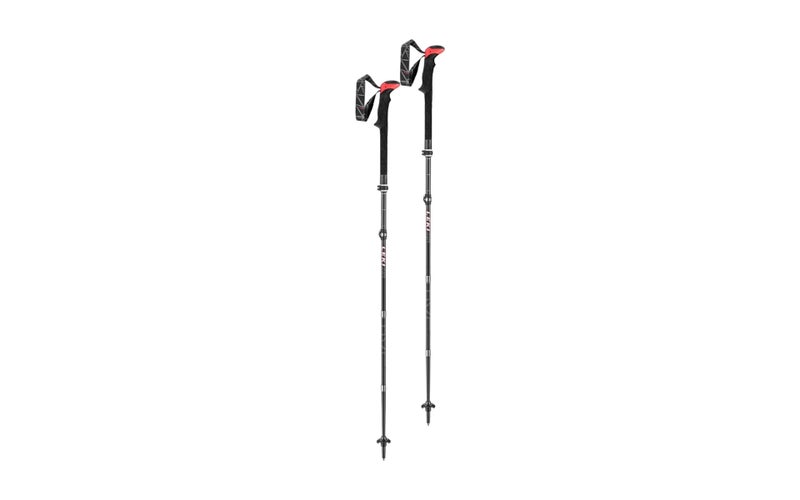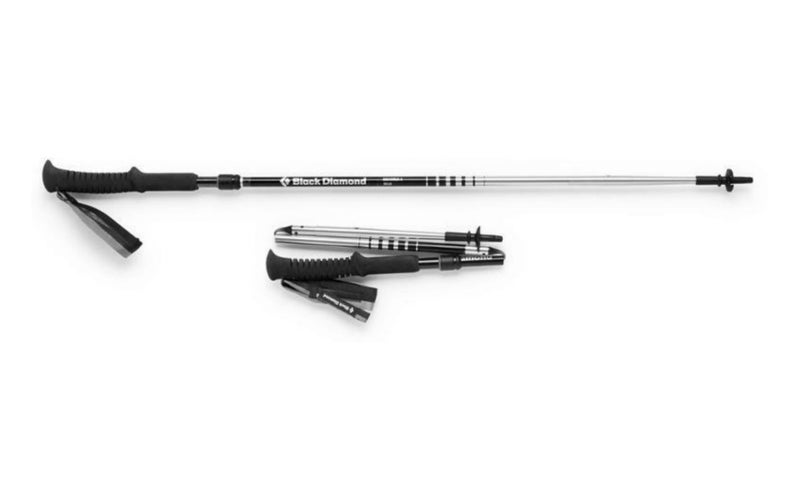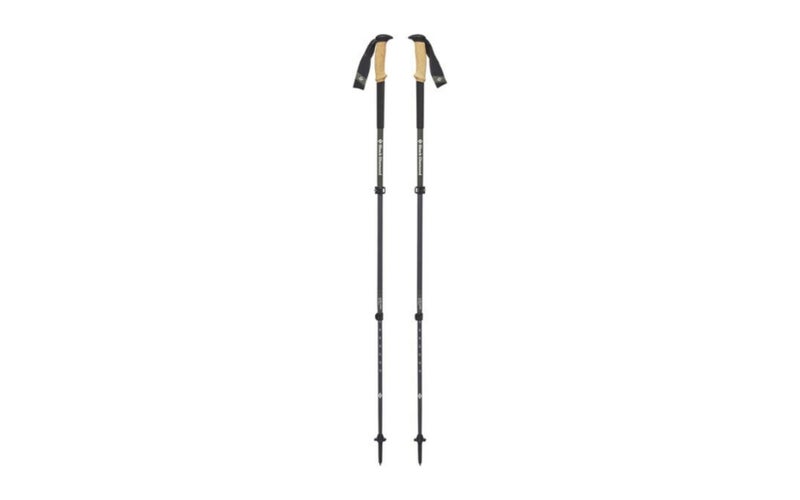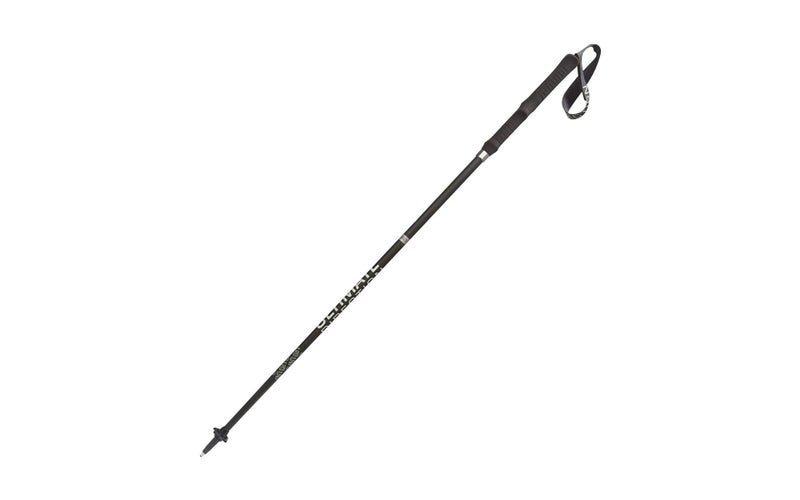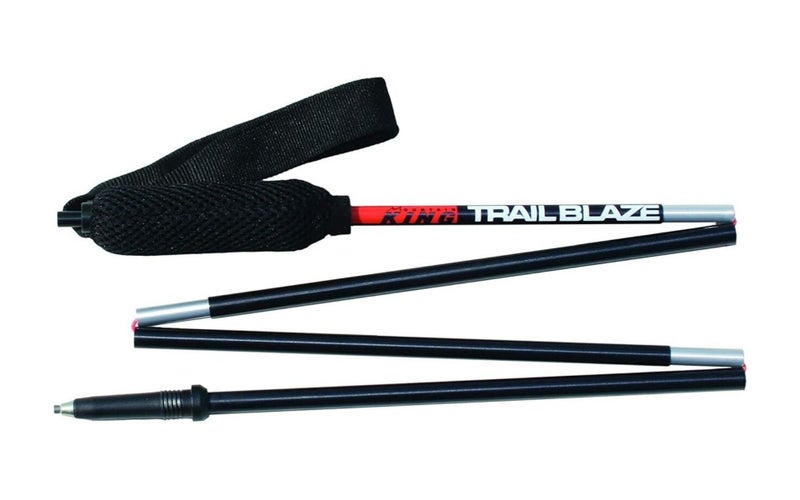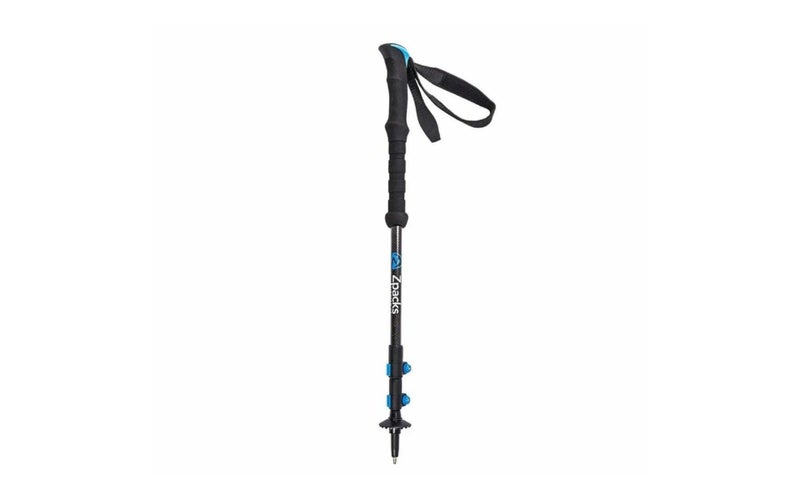We may earn revenue from the products available on this page and participate in affiliate programs.
Hiking poles have been a standard part of my packing list for a few years now. I used them — well, one — for the first time during a 2015 climbing trip in Grand Teton. After reaching the top, we had to make the 7,000-foot descent back to the trailhead through rocky terrain. Standing 6-foot-3, I felt like a giraffe walking on stilts as my guide cruised down the talus slope using trekking poles.
He noticed how slow I moved and offered to let me try one of his poles for a few miles. I immediately noticed a difference. With a third-point of contact, I felt more stable and confident moving downward over the loose, rocky terrain. As soon as I got home, I ordered a pair and started using them every time I went out.
Over the past six years of use, hiking poles have allowed me to move over rugged terrain quickly and confidently while carrying a heavy pack. They’ve also saved me from having a number of bad falls and kept me (relatively) injury-free. I highly recommend them. With that said, here are my picks for the best hiking poles.
The Leki Micro Vario Carbon three-piece Z poles are strong, lightweight, and exceptionally stowable and packable. They were recommended to me by seasoned backpacker Jessica “Dixie” Mills. In addition to completing the triple crown (Appalachian Trail, Continental Divide Trail, and Pacific Crest Trail), she also runs the incredible Homemade Wanderlust gear channel.
What I love most about the Micro Vario is that it’s a telescoping design that’s also very strong. The speed lock system enables you to extend the poles for downhilling and shorten them for uphilling. The lightweight adjustable strap is supportive and the grips are ergonomically designed and comfortable. The Micro Vario Carbon poles pack smaller than most poles I’ve seen. These poles are ideal for long-distance backpacking and alpine use.
The Leki pole features Aergon Thermo grips, which are super comfortable and use an edgeless, rubberized and textured surface that accommodate multiple gripping positions. The wrist straps are made from breathable, lightweight, soft material and provide good support and comfort.
The Z pole sections lock together tightly, and each pole is adjustable in length via the SL2 locking system by 20 cm. The SL2 system is easy to use even when wearing gloves. The External Locking Device is super intuitive and fast and easy to assemble and disassemble with the push of a button.
Additionally, its internal tensioning cable is protected with vinyl. The carbon fiber shafts absorb shocks on hard surfaces well, and the thick shafts are both strong and durable. Each pole sports a small basket to prevent sinking into soft surfaces and protect the lower shaft. The baskets are easily exchangeable without tools. Finally, the flex tips feature tungsten carbide end tips for superior grip in all terrains.
- Weight: 480 grams (1.05 lbs) (pair)
- Usable length: 110 to 130 cm (43 to 51 inches)
- Collapsed length: 40 cm (15.7 inches)
- Grip material: Aergon Thermo foam
- Shaft material: Carbon fiber
Strong, light, and durable
Super comfortable grips
Adjustable and versatile
More limited in length than other brands
Expensive
In 2015, I bought the Black Diamond Distance Z Trekking Poles at the recommendation of Brian Smith, an internationally certified mountain guide and lead guide at Exum Mountain Guides. Over six years, I put more than 600 miles on them along the Appalachian Trail. I wore out a set of tungsten carbide tips and replaced them, and wore out the wrist loops and replaced them, too. I’d still have the poles today if I didn’t destroy one tumbling down the Muir Snowfield last summer. It bent into a complete U, but it kept me from bashing my head open on the rocks — so they did their job.
The Black Diamond poles are relatively light at 402 grams per 130 cm pair and are ideal for everyday use by trail runners and day hikers. They are the company’s most affordable Z pole with shafts made from lightweight 7075 aluminum. Since I bought my first pair, they’ve changed the grips from cork to lightweight EVA foam, improved the SlideLock technology, and increased joint durability. The wrist straps are light but supportive and wick away moisture on those high intensity days. The internal tensioning cable is protected by vinyl at the joints and the tips, which feature a small integrated basket, and accommodate both carbide and rubber tech tips. They are also snow basket-compatible and available in seven sizes.
Simply put, these poles performed excellently, especially at a mid-range price point. Plus, Black Diamond offers an excellent warranty. When I destroyed mine five years past the expiration date, they gave me a 40 percent discount on a new pair. While they’re designed for running and fastpacking, I’ve used them on alpine ascents and they held up well.
- Weight: 342 to 401 grams (12.1 to 14.2 ounces) depending on size
- Usable length: Seven sizes from 100 to 130 cm
- Collapsed length: 33 to 43 cm (13 to 178 inches) depending on size
- Grip material: Lightweight EVA foam
- Shaft material: 7075 aluminum
Lightweight
Relatively rugged (not intended for heavy pack use)
Very stowable
Not adjustable
Thin wrist straps aren’t the most comfortable
Wrist straps wear out after a few hundred miles
After I bent the shit out of one of my Black Diamond Z poles, I contacted the company to see about my options. Since they were long past warranty, Black Diamond instead gave me 40 percent off a new pair. Looking to upgrade, I grabbed the Black Diamond Alpine Carbon Cork poles because they were popular among climbing guides, and I instantly fell in love.
The Black Diamond Alpine Carbon Cork trekking poles are made from 100 percent carbon fiber and built to withstand four-season use in alpine terrain. The cork grips are comfortable and ergonomically designed. They insulate a bit on cold days and also don’t feel slimy when your hands are sweaty. The rubber tops of the poles are convex and comfortable when pushing off with the palms of your hands. The grips also feature adjustable wrist loop straps to allow you to simultaneously retain your poles and use your hands, and provide your wrists a bit more support when using the poles.
The carbon fiber shafts are durable and lightweight and constructed of three telescoping sections kept in place with aluminum FlickLock Pro locking mechanisms that enable adjustment from 100 to 130 cm (39 to 51 inches). The shafts are marked in 5 cm increments to enable quick adjustments and to ensure both poles are the same length. I like the adjustability of these poles much better than the fixed length Z poles because I can shorten the length when ascending hills and extend them when descending.
The end tips of the poles feature a small 38 mm basket to help keep them from over penetrating soft dirt or snow. They will also accept 100 mm powder baskets if you want to use them for snowshoeing or skiing. The ends are removable and come with carbide tech tips to increase durability and minimize slippage on rock and ice. Grippy rubber tips can be purchased separately.
While these trekking poles are on the more expensive end of the spectrum, they are tough, lightweight, very sturdy, and versatile. While not the lightest trekking poles on the market, they are some of the strongest. Considering I weigh about 215 pounds, I’ll trade a few ounces for the stronger poles as I already destroyed a lighter aluminum pole while tumbling down the Muir Snowfield with a 65 pound pack on my back.
- Weight: 486 grams (1 lb 1.1 oz) (120 cm pair)
- Usable length: 100 to 130 cm (39 to 51 inches)
- Collapsed length: 61 cm (24 inches)
- Grip material: Cork
- Shaft material: Carbon fiber
Lightweight
Rugged, durable
Ergonomic, comfortable
Adjustable length, and customizable baskets and tips
Not adjustable
The Ultimate Direction FK Ultra poles are designed for trail running and are some of the lightest I could find on the market. The FK — meaning “fastest known” (time) — are meant for people who do a lot of trail running.
While the handles aren’t the most comfortable and not made of cork, they do offer two different grip zones for two-handed single pole use. The tops of the handles lack rounded ergonomic palm pads, which makes them less comfortable when pushing off. The excessively branded wrist leash straps are thinner than most to save weight, but are very comfortable. The poles themselves have a really light swing weight, making them nice for running.
They come in seven different sizes from 105 cm to 135 cm and are collapsable for easy storage and transportation. The lowest third segment contains an internal custom tensioner to adjust the shaft rigidity. The tapered shaft is designed to increase the strength-to-weight ratio and provide increased rigidity at the joints. The FK Ultra poles also come with two styles of interchangeable baskets for use on snow or dirt. Finally, the pin-style locking mechanism is fairly straightforward and easy to use although it sounds a bit creaky when deploying.
While I prefer adjustable poles, these collapse into a fairly small, stowable package. The light swingweight and grip and wrist strap combination work very well when climbing hills. While these poles excel for trail running, they wouldn’t be my first choice for heavy loads, rugged terrain, and off-trail movement.
- Weight: 330 grams (11.64 oz) per 120 cm pair
- Usable length: Seven sizes from 105 to 135 cm (41.3 to 53.1 inches)
- Collapsed length: 42 cm (16.5 inches)
- Grip material: EVA foam
- Shaft material: carbon fiber
Super lightweight
Strong carbon fiber tapered design
Built-in tensioner
Expensive
Internal tension cord lacks protective plastic
Clunky locking mechanism
The Mountain King Trail Blaze Carbon Ultra Poles are minimalist four-section fixed-length poles specifically designed for ultramarathoners. Ultramarathoners are insane, so I wanted to find the lightest poles available for those gram-conscious maniacs.
The Mountain King Trailblaze poles are very functional and 100 grams lighter than the Ultimate Direction FK Ultras. Plus, they’re easy to deploy and dismantle. But they do have some drawbacks, specifically with the connecting cord and handles.
To deploy the poles, you have to pull up on the internal cable and lay a knot in the cord into a groove in the top of the handle, which leaves about 10 inches of excess cord out of the handle. The designers built a Velcro strap below the padded handle to secure the cord, but it still flops around below the Velcro. I could see how deploying these would suck with cold or gloved hands.
The handles themselves aren’t the smoothest, and some users have noted that they got blisters from the material while using them for extended periods of time, so it might be good to wear thin gloves while using them. The wrist straps are not adjustable (boo!), so you can’t customize the length and fit. Also, the shafts aren’t the burliest, so they’ll flex on you a bit, especially when heavily loaded. They do come with decent mud/snow baskets and tungsten carbide tips, though.
When you’re running 50-plus miles in a day, every ounce matters and these are so light you might forget you are carrying them. Use them for masochistically long ultra trail races, but don’t take them backpacking.
- Weight: 220 grams (7.7 oz) (per 120 cm pair)
- Usable length: Five sizes from 110 to 142 cm (43 to 55 inches)
- Collapsed length: 30 cm (11.8 inches)
- Grip material: Foam
- Shaft material: Carbon fiber
Super lightweight
Functional
Affordable
Very stowable
Somewhat brasive grips
Unprotected tensioning cord
Flexy shafts
Zpacks is a company well-loved by long-distance backpackers for their exceptionally lightweight equipment, so it’s no surprise they make a pair of well-made, lightweight telescoping poles that are also fairly affordable.
The Zpacks Carbon Fiber trekking poles are made with 100 percent carbon fiber shafts and feature foam or cork grips that offer two grip positions, padded wrist straps, sturdy adjustable clasp locks, a small snow/mud basket, tungsten carbide tips, and rubber road tips for use on pavement.
What I particularly like is that Zpacks sells these poles individually, so if you just want one, you have that option. Of course, you get two poles for a slightly less price per pole. They are also designed to serve as main poles for some of Zpacks’ lightweight tents.
- Weight: 410 grams (14.4 oz) (per foam handled pair)
- 434 grams (15.4 oz) (per cork handled pair)
- Usable length: 100 to 137 cm (39 to 54 inches)
- Collapsed length: 62 cm (24.5 inches)
- Grip material: Foam or cork
- Shaft material: Carbon fiber
Lightweight
Comfortable cork grips
Can buy individually
Budget-friendly
Not the most stowable/collapsable
Locks are plastic not aluminum
Why you should trust us
I’ve been an outdoorsman for more than 35 years. I’m an avid long-distance backpacker, rock climber, and mountaineer who understands the value well-designed gear delivers, especially when your life depends on it. I don’t get paid by the manufacturers and have editorial independence. My editor leaves it to me to recommend and prints what I write. All of this enables me to provide you, our valued readers, with our unvarnished, honest opinions on the recommendations we make.
Types of hiking poles
Trekking poles come in several styles, adjustable length and fixed length, and come with an array of features.
Adjustable
These poles are generally telescoping in design and allow the user to shorten the poles when climbing uphill and lengthen them on downhills for additional stability and efficiency in rugged terrain. They generally allow the user to adjust them from 60 cm (24 inches) in a completely collapsed and stowable position, to 140 cm (55 inches) in a fully extended position. They tend to be somewhat heavier and more sturdy than fixed-length poles.
Fixed
Fixed-length poles are just that: They come in one size and don’t adjust, so be sure to buy the right size for you. They can either be a solid pole or one that typically collapses into three or four foldable segments, commonly referred to as Z poles. They tend to pack smaller, are more lightweight, but are less durable and strong than adjustable poles.
Ultralight
Ultralight poles can be adjustable but are more commonly fixed and designed to minimize swing weight when running. This makes them lighter, less strong, and faster to move with the flick of a wrist. When running dozens of miles, every ounce counts, and less weight in the hand means less fatigue over the hours. These poles typically weigh less than a pound per pair.
Key features of hiking poles
Grips
Most trekking poles come with either cork, foam, or some sort of rubber grips. I tend to prefer cork grips since I do most of my long-distance hiking on the East Coast with its rain and humidity. Cork stays grippy when wet and doesn’t get slimy. It also insulates a bit, cushions a bit of shock, and molds to your hand over time. Foam tends to be the softest in hand, but also absorbs moisture. Rubber also helps insulate from cold and shock, but can get slimy in warmer, more humid climates.
Wrist loops
Wrist loops provide additional stability and support, especially when pushing off on inclines. They also keep the poles attached to your body while enabling your hands to do other tasks. Look for wrist loops that are adjustable and replaceable, and padded for comfort. Most come in left and right-hand variants.
Shafts
Trekking pole shafts are typically made out of two materials: either aluminum or carbon fiber. Aluminum shafts are less expensive, more durable, and the weight varies based on the thickness of the shaft material. They can typically withstand a good deal of stress and will bend but not likely break. Carbon fiber shafts are lighter and tend to dampen more shock than aluminum. They are also more expensive. Under high stress, they are also more likely to break.
Baskets and tips
Baskets are small disk-shaped pieces of plastic that are situated a few inches from the tip of the poles. They help prevent the poles from sinking into soft dirt or snow by increasing the surface area of impact. The pole tips are generally made from tungsten carbide or steel to provide additional traction on rock and ice, or rubber for use on roads.
Benefits of hiking poles
Stability and balance
The most important benefit of trekking poles is that they help keep you upright and help prevent you from busting your ass on rugged terrain far from home. This advantage is more than creature comfort. They help prevent injuries when you are far from medical assistance. They also help make your hikes more enjoyable and help you move more quickly through loose, wobbly, or flooded terrain.
Forward momentum
Trekking poles also help you move faster and more efficiently through rugged terrain, especially while ascending or descending hills.
Shock absorption
When descending, your body — especially your knees — takes a lot of shock, especially while carrying a heavy pack. Trekking poles help dampen some of that shock through the shaft and also transfer some of it to your upper body via your arms. This helps reduce fatigue.
Pricing considerations for hiking poles
Budget
I believe that if you don’t buy nice, you’ll end up buying twice — but I also know budget is a consideration for many of us. I consider anything under $75 to be inexpensive. The lower you go in price, the more you need to check the quality of the poles and their hardware. Cheap also tends to mean heavier.
Mid-range
There are plenty of affordable quality trekking pole options in the $75 to $125 range. You’ll find most poles in this range to have the most essential features and provide solid performance and value.
Premium
I consider anything in the $125 to $225 range to be expensive poles. When you pay this much, you’re typically paying for advanced materials that enable lightweight or ultra-lightweight design. These poles will typically have more comfortable grips and fold or telescope in for the most packable, smallest packages.
How we chose our top picks
All the trekking poles in this review were selected based on hands-on inspection, interviewing other experts, and thoroughly reviewing manufacturers’ specifications. We take our time to get to know the strengths and weaknesses of each item, and also check out the reviews of other experts just to make sure we’re not missing anything.
FAQs on hiking poles
You’ve got questions, Task & Purpose has answers.
Q. How do I use hiking poles?
A. First, you need to decide whether you want one or two poles. Most people choose two. Next, you need to make sure you get the right length. Look for poles that allow your elbow to bend at 90 degrees when the pole tips are on the ground. There’s also a technique for using the poles. Alternate hands and legs while moving and keep the tips behind the handles to help push you forward.
Q. Are hiking poles worth it?
A. Hell, yes. I used to pooh pooh them, but once I tried them, I was sold and have used them for six years now. I won’t go hiking without them because I feel much more stable and efficient when moving over rough terrain, especially when carrying a heavy pack.
Q. Why use hiking poles?
A. Safety and efficiency. The further you go from the trailhead, the more self-reliant you need to be. Trekking poles help keep you upright and assist in preventing you from crashing and injuring yourself. Mine have saved me from twisted ankles, broken bones, and expensive dental repair work. Also, they add your arms into the propulsion system and help you move faster and more confidently over rough terrain.
Q. Can you take hiking poles on a plane?
A. Yep. If you are going to travel, consider using Z style poles that fold up into packages about 15 inches in length or smaller.
Our gear section
Joe Plenzler is a Marine Corps veteran who served from 1995 to 2015. He is a backcountry expert, long-distance backpacker, rock climber, kayaker, cyclist, wannabe mountaineer, and the world’s OK-est guitar player. He is currently section-hiking the Appalachian Trail with his partner, Kate Germano. He supports his outdoor addiction by working as a human communication consultant, teaching at the College of Southern Maryland, and helping start-up companies with their public relations and marketing efforts
